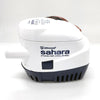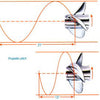How to Order the Correct Outboard Parts for Your Engine (SSI Marine Guide)

How to Order the Right Part for Your Outboard – SSI Marine
Ordering outboard parts can be confusing — many parts look similar, but they will not always fit your specific engine. At SSI Marine, our goal is to help you get it right the first time so you can enjoy more time on the water and less time dealing with exchanges and returns.
This guide will help you:
- Find your engine model and serial number
- Understand special engine cases (Mariner, High Thrust, Command Thrust, Big Foot)
- Choose the correct propeller size and pitch
- Avoid the common mistakes we see every day
If you’re ever unsure, simply email us — we’re always happy to assist.
Step 1 — Ordering the Right Part for Your Outboard
Every outboard part is engine-specific. Even parts that look identical may differ internally and will not fit your model.
We always build our product descriptions using our own research and experience, but the most accurate way to identify parts is by using your engine’s details.
Before placing an order, please:
- Find your model and serial number
- Check that the part is listed as suitable for your exact model
- If in doubt, email us and we’ll verify compatibility for you
We do have our own internal part lists, but due to manufacturer policies we’re not allowed to publish them online. However, with your engine details, you will find very good exploded diagrams and parts breakdowns available on the internet. If you ever need help identifying the right part, just email us your engine model and serial number — we’re always happy to help.
Step 2 — How to Find Your Engine Serial Number
Your outboard will have a metal plate or durable sticker on the engine bracket (transom mount). This plate shows:
- Model
- Serial number
- Horsepower / variant
- Year code (depending on brand)
Tip: These plates can become dirty or faded. Take a clear photo so you always have a record.
Brand-by-Brand Identification Guide
Yamaha Outboards
Yamaha plates typically show:
- Model name
- Prefix model code
- Transom length
- Serial number
- Year code
Use the combination of prefix and year code to match your engine precisely.


Suzuki Outboards
Suzuki serial labels typically include:
- Model (e.g. DF6A)
- Serial code
- Manufacturer information
Always send us the full printed code so we can match the exact parts diagram.

Mercury Outboards
Mercury labels normally include:
- Model number
- Serial number
- HP and kW rating
- Weight and CE markings
You’ll usually find the label on the transom bracket or swivel bracket.

Mariner Outboards
Mariner outboards can be a mix of Yamaha- and Mercury-built engines.
- 2-stroke models up to about 1992: Yamaha-built (uses a Yamaha-style identification plate).
- 2-stroke models after 1992: Mercury-built (uses a Mercury-style identification plate).
- All 4-stroke Mariner outboards: Mercury-built.
These examples help you see whether your Mariner is effectively a Yamaha-type or a Mercury-type engine, which is important for ordering the correct parts.


Honda Outboards
Honda uses slim black metal tags showing:
- Model
- Serial number
- “Made in Japan” marking

Tohatsu Outboards
Tohatsu plates are usually white stickers showing:
- Model (e.g. MFS4B)
- Serial number
- Rated power and full-throttle RPM range

Johnson / Evinrude Outboards
Johnson & Evinrude engines have their own plates, typically on the transom or swivel bracket, showing the model and serial number.

If the Serial Plate Is Missing
Sometimes the plate is missing, painted over, or too worn to read. Don’t worry — we can still help.
Please email us with:
- A clear photo of the engine with the cowling on
- A clear photo with the cowling off, showing the powerhead
- Any visible casting numbers or stickers
- A short note about which parts you’re looking for
We’ll do our best to identify the model and recommend the correct parts.
Special Case: High Thrust / Command Thrust / Big Foot Gearboxes
Some engines on the market use a High Thrust, Command Thrust or Big Foot gearbox.
For example, your engine might be a 50HP, but with a Big Foot or Command Thrust gearbox from the next size up. In that case:
- Most powerhead / block parts match the standard 50HP.
- Gearcase parts (propeller, impeller, anodes, seals, etc.) match the larger gearbox.
When ordering gearbox parts, please always check whether your engine is Standard, High Thrust, Command Thrust or Big Foot. If you are not sure, email us and we can help you check.
Choosing the Right Propeller for Your Outboard
This is one of the most common questions we receive.
The same horsepower engine (for example a 50HP) may be fitted to:
- A RIB
- A small open boat
- A cabin boat
- A 5m hull or a 7m hull
Each setup may require a different propeller to perform properly.
To choose the correct propeller, you need to:
- Make sure the hub / spline type matches your outboard
- Choose the correct diameter and pitch for your boat and load
A typical prop size looks like this:
11 1/8 x 12 — 11 1/8 is the diameter, 12 is the pitch.
If you send us your current prop size, engine model, and boat details, we can guide you in choosing a suitable propeller.
Do You Need a Different Pitch?
You may need a different propeller if:
- The boat is sluggish getting on plane
- You are not reaching the recommended WOT (Wide Open Throttle) RPM
- Your top speed is lower than expected
- The engine sounds like it’s over-revving or under-revving
- The propeller ventilates or “blows out” in turns or under load
RPM and Pitch Relationship
Pitch and RPM are inversely related:
- More pitch → lower RPM
- Less pitch → higher RPM
As a general rule of thumb:
- A 2-inch increase in pitch will usually reduce RPM by about 300–400 rpm.
- A 2-inch decrease in pitch will usually increase RPM by about 300–400 rpm.
Check your owner’s manual for the correct WOT RPM range. Running outside this range for long periods can cause engine damage.
Final Notes
Everything in this guide comes from real experience helping customers choose the correct outboard parts.
Ordering correctly means:
- No wasted time on returns and exchanges
- Faster delivery of the parts you truly need
- No missed sunny boating days because the wrong parts arrived
If you’re unsure about anything, please contact us — we’re here to help.
Email: parts@ssimarine.co.uk
Website: www.ssimarine.co.uk
Thank you for your business,
Danny & Julian





